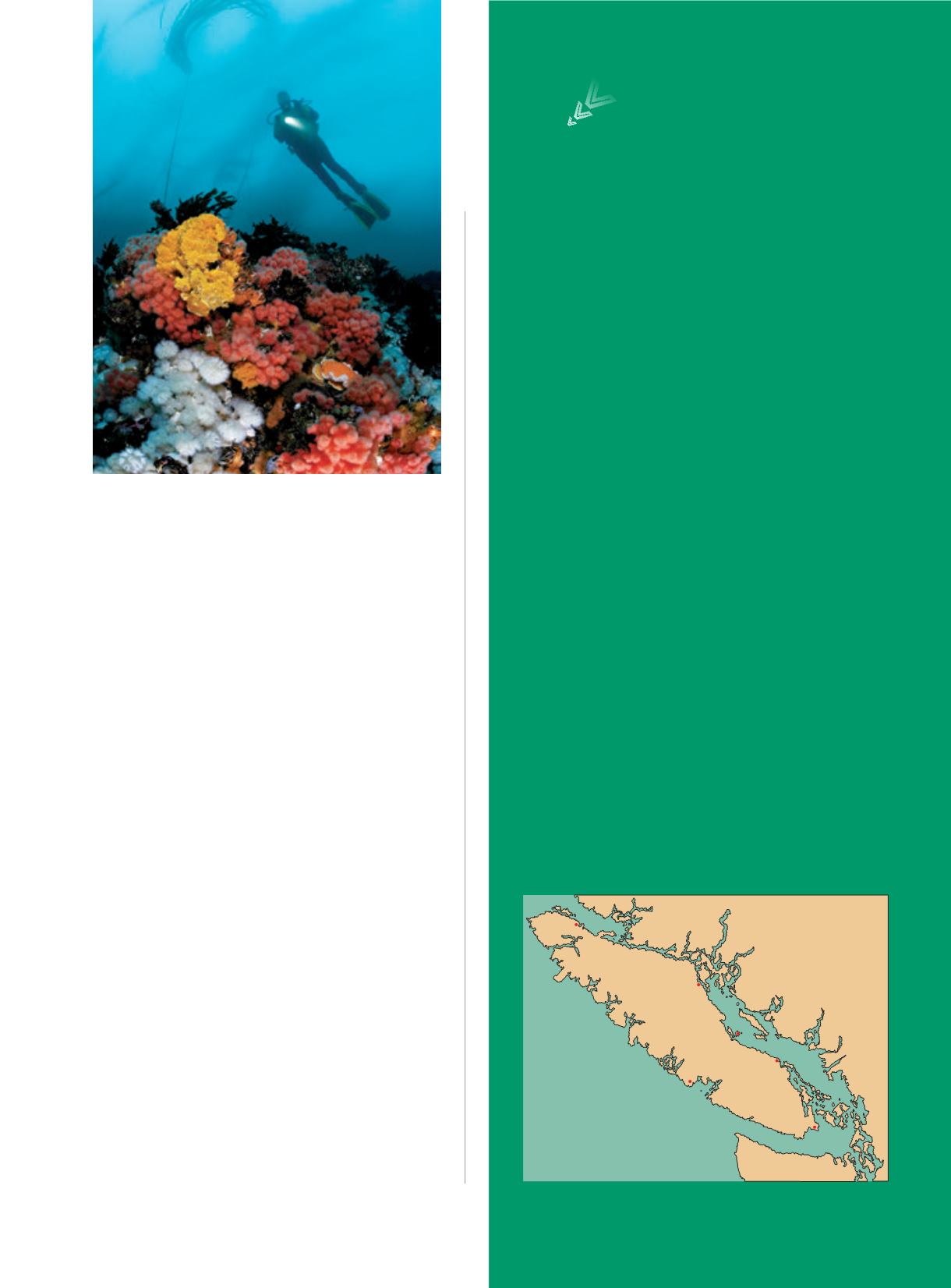
 ALERTDIVER.COM
ALERTDIVER.COM
|
79
gold opalescent nudibranchs sliming their way
through a turf of iridescent algae. Yellowtail rockfish
are in squadron formation in the kelp atop the
saddle-shaped reef’s ridges. At
Chris Rock
we see
shimmering ratfish, most alien in appearance, gliding
over the sand bottom. We glimpse a swimming
Stomphia
sea anemone lift off the rock to escape
a hungry leather star. A surprisingly cooperative
decorated warbonnet with bulging eyes and a
disheveled punk hairdo monopolizes my bottom time
at
Seddall Island Wall
. Alas, no gas is left to pursue
pictures of other little beasties.
Barkley’s plankton-rich waters are stocked with
giants. Sunflower stars 3 feet across roam about
on 14 legs, plumose anemones resembling steroid-
pumped cauliflowers tower everywhere, and GPOs
lurk in dens by day, anticipating their midnight
meals. Super-sized jellyfish pulse by like luminescent
spaceships in orbit. The holy grail of the area’s
megafauna, however, may be the sixgill shark. During
summer months, target
Tyler Rock
for a chance
to swim alongside this “Jurassic shark,” a primitive
elasmobranch ancestral to modern five-gilled shark
species. Tyler Rock is one the few sites on Earth
where the very lucky diver might encounter, at
recreational depths on scuba, these enigmatic slow-
moving sharks that normally inhabit the deep sea.
As I descend through my buddy’s bubbles and
strain to see the bottom somewhere down there in
the gloom, I flash back to an epic dive here some 15
years ago. Memories come to life as a shadowy form
takes shape.
AD
Pacific
Ocean
Port
Hardy
Barkley
Sound
Victoria
Nanaimo
Campbell
River
Hornby
Island
WASHINGTON
Vancouver
Island
B R I T I S H
C O L UMB I A
How to Dive It
CONDITIONS:
In general, Vancouver Island’s mild climate means
diving and topside fun year-round. (Extreme weather is possible
outside of Port Hardy during winter months, however, which can
limit diving opportunities there during December through February.)
Each diving region has its own best season, so check with local
operators. In general, autumn and winter months have better
visibility (averaging 30 to 80 feet). Summer months deliver more sun,
warmer weather topside (65°F to 85°F, depending on the region) and
usually calmer seas. The water temperature averages about 50°F but
varies between 45°F and 55°F, depending on the region and season.
A full 7 mm wetsuit, semidry suit or drysuit is required. Drysuits are
recommended for multiday diving trips. Topside weather is often
glorious in late summer and fall, with daytime temps in the 70s°F.
TIDES AND CURRENTS:
For currents and tides, consult Canadian
Tide and Current Tables at
tides.gc.ca/eng/find/region/1 .Caution:
Make sure you also consult experienced local divemasters and boat
captains. Slack water can be difficult to predict using only a printed
chart. We strongly recommend you begin your Vancouver Island diving
by going with experienced, local operators.
GENERAL VANCOUVER ISLAND TOURISM INFORMATION:
hellobc.com/vancouver-island.aspx
GETTING THERE:
From British Columbia, take a ferry (
bcferries.
com
) from Tsawwassen or Horseshoe Bay (near Vancouver city) to
Nanaimo or Victoria. From Washington, take a ferry (
wsdot.wa.gov
)
from Anacortes to Sidney (just north of Victoria). Victoria Clipper
passenger-only ferries
( clippervacations.com )connect Seattle
and Victoria.
Access the following airports on Vancouver Island via Vancouver
(city): Nanaimo (YCD), Victoria (YYJ), Port Hardy (YZT), Campbell
River (YBL), Port Alberni (YPB).
A diver swims above a colorful wall carpeted
with invertebrates including raspberry soft coral
(
Gersemia rubiformis
), plumose sea anemones
(
Metridium senile
) and yellow encrusting
sponge (
Myxilla lacunosa
).


















